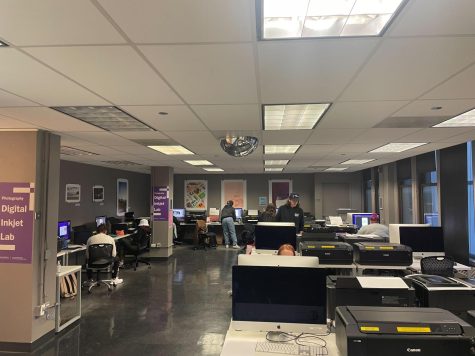Number of online courses doubles since before the pandemic
May 3, 2023

About 10% of the courses offered at Columbia are online this semester, which is more than double what it was before the pandemic.
The percentage has remained fairly consistent over the last three semesters, said Senior Associate Provost Nathan Bakkum.
Bakkum said in spring 2023, 170 course sections have been taught fully online, 72 of which were asynchronous and 98 were synchronous courses.
Columbia canceled on-campus events beginning March 15, 2020, at the start of the pandemic and temporarily suspended classes so instructors could convert them online. Classes then resumed online on April 6, 2020, after spring break, though Commencement was canceled.
By the Fall 2020 semester when the campus reopened, the majority of classes were still offered solely online.
Bakkum said departments can choose to develop new courses as fully online offerings or they can adapt existing courses for online. All faculty must successfully complete a four-week online course before they are deemed qualified to deliver an online course.
Laurence Minsky, professor and director of Graduate Programs in the Communication Department, said success in an online course depends on the student.
For comparison, Bakkum said in fall 2019, the college taught 78 online courses, where only two were synchronous. In fall 2018, Columbia had 75 online options and all of them were asynchronous.
Minsky said students were pushing for more online classes prior to COVID-19.
“Before the pandemic, there was a call to increase the number of them, because it could make it easier for students with their scheduling — four in person and one online,” he said.
Minsky added that at this point, students are used to taking online classes.
Karolina Dziatkowiec, a senior journalism major, likes having more online options because she is a commuter student.
“I feel like it’s more accessible instead of having to commute every single day,” said Dziatkowiec, who is taking “Writing Digital Content” and “Nutrition” online this semester.
Cyera Williams, a senior communication major, like the format but misses interacting with other students when taking online courses.
“I don’t think you get the full experience of the class and interacting with other students when you are online because no one likes to talk online,” Williams said.
Keanu Martinez, a junior game art major, also misses interacting with his peers in person.
“There’s this weird dichotomy I have with it,” Martinez said. “I was able to work at my own pace when the classes were online, but the social aspect was missing.”
Minsky has taught courses both in-person and completely online. He said not all classes are able to work online, but can be helpful for students who will be working online for their careers.
Minksy said there are some hurdles with teaching online, such as locating and developing digital materials for online classes, as well as Zoom fatigue.
One of his courses, “Social Media Content,” can be taught in a variety of formats.
“Starting from the online asynchronous and then going to in-person made it easier to convert the course to both modalities,” Minsky said.







